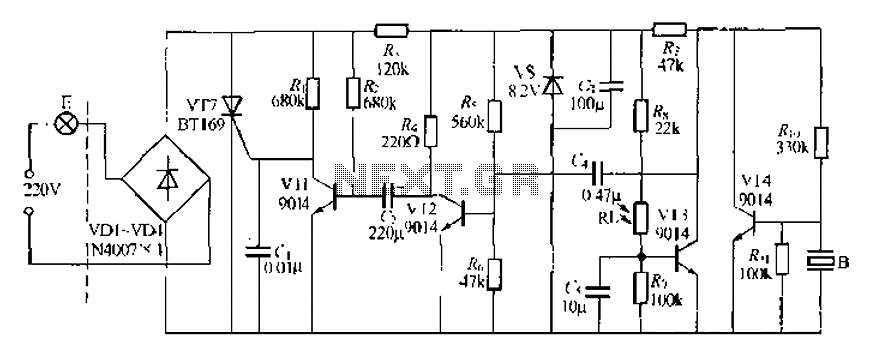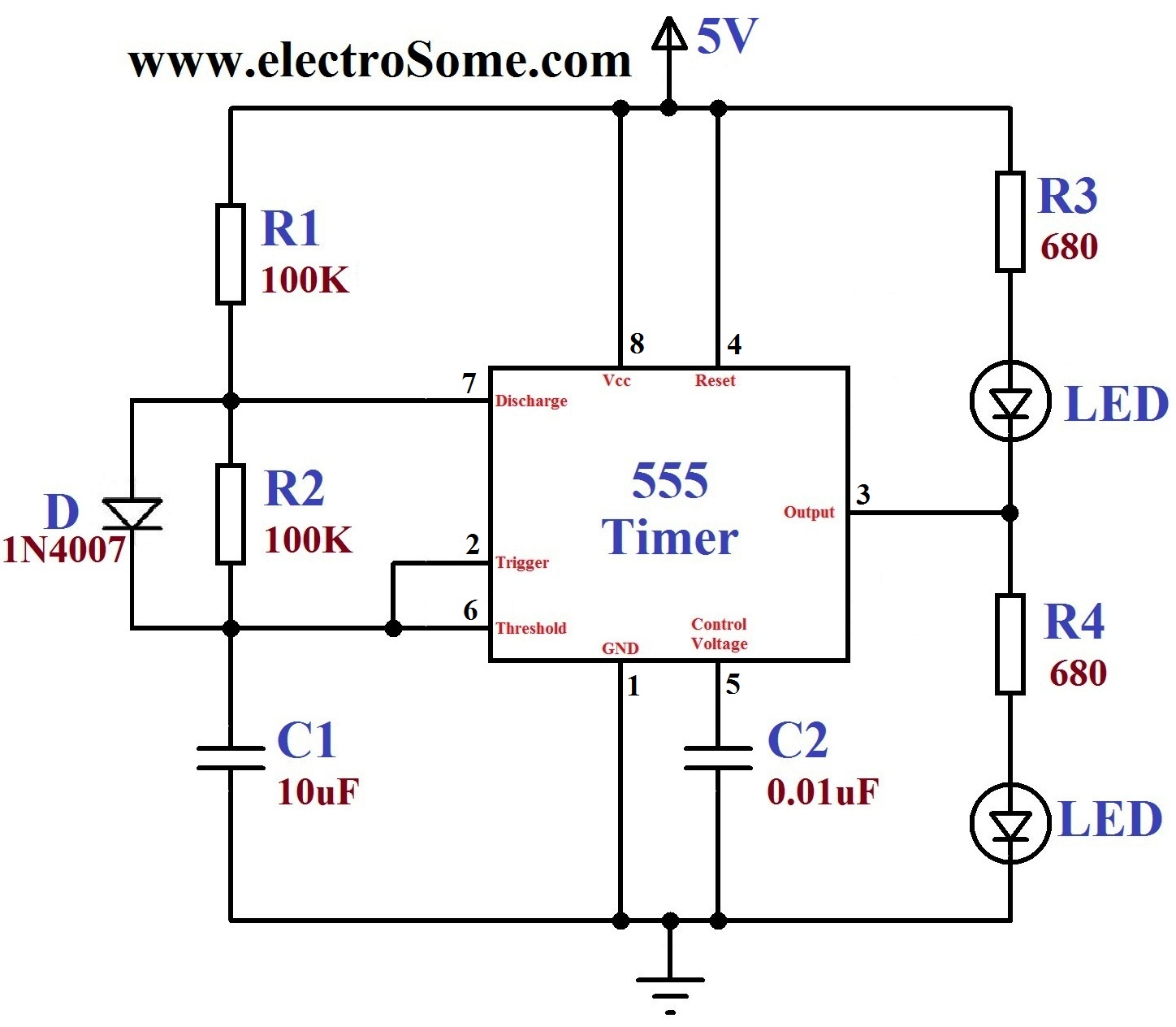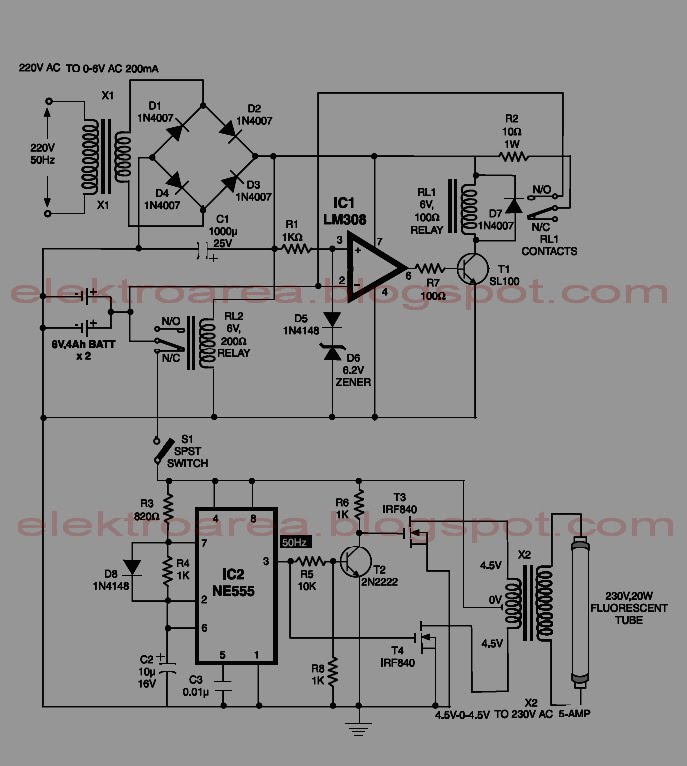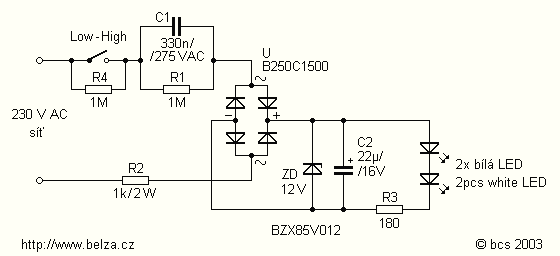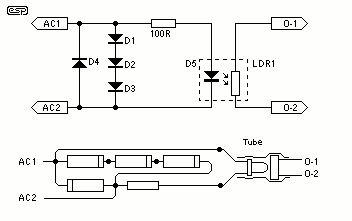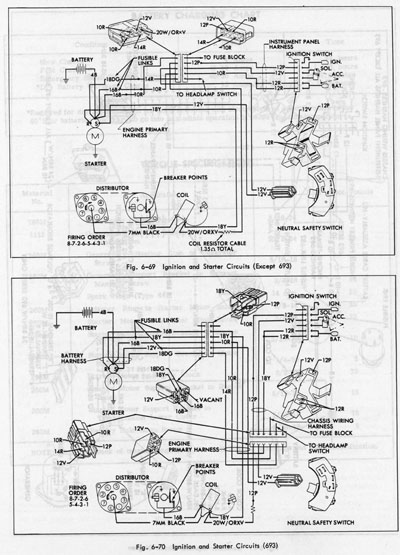
Fully Automatic Emergency Light
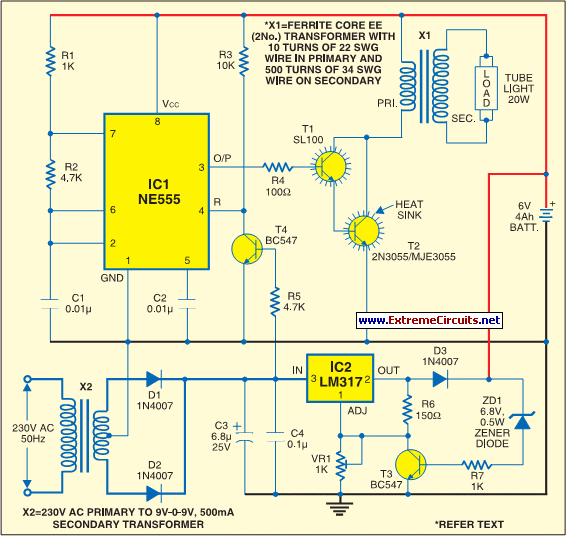
The charging circuit automatically stops when the battery is fully charged, allowing the emergency light to remain connected to the AC mains overnight without concern. The circuit is divided into two sections: the inverter and the charger. The inverter section utilizes the NE555 timer, while the charger section is based on the LM317 adjustable regulator. In the inverter section, the NE555 is configured as an astable multivibrator that generates a 15 kHz square wave. The output from pin 3 of the NE555 is connected to a Darlington pair formed by transistors SL100 (T1) and 2N3055 (T2) through resistor R4. This Darlington pair drives a ferrite transformer (X1) to illuminate the tube light. The inverter transformer X1 is constructed using two EE ferrite cores (each measuring 25G—13G—8mm) with a plastic former. The primary winding consists of 10 turns of 22 SWG wire, while the secondary has 500 turns of 34 SWG wire, with insulation between the two. To connect the tube light to the ferrite transformer X1, both terminals on each side of the tube light should be shorted and then connected to the secondary of X1. Alternatively, a Darlington pair of transistors BC547 and 2N6292 can be used for a 6W tube light with the same transformer. When mains power is available, reset pin 4 of the NE555 is grounded via transistor T4, preventing the NE555 from producing a square wave and turning off the emergency light. In the event of a mains failure, transistor T4 stops conducting, allowing reset pin 4 to receive a positive supply through resistor R3. This causes the NE555 to generate a square wave, turning on the tube light via ferrite transformer X1. In the charger section, the input AC mains is stepped down by transformer X2 to provide 9V-0-9V AC at 500mA. Diodes D1 and D2 rectify the transformer output, while capacitors C3 and C4 filter out ripples. The unregulated DC voltage is then supplied to the LM317 (IC2). By adjusting preset VR1, the output voltage can be set to the desired charging voltage. When the battery voltage exceeds 6.8V, zener diode ZD1 conducts, causing regulator IC2 to stop outputting the charging voltage. The circuit should be assembled on a general-purpose PCB and enclosed in a cabinet that provides sufficient space for the battery and switches. A 230V AC power plug is required to supply charging voltage to the battery, and a 20W tube outlet should be included in the cabinet for the tube light.
The circuit design effectively integrates an inverter and a charger, ensuring that the emergency lighting system functions seamlessly. The NE555 timer's configuration as an astable multivibrator is critical for generating the necessary square wave to drive the tube light. The choice of a Darlington pair enhances the current amplification needed to operate the ferrite transformer, which is essential for lighting the tube. The transformer construction details provide insight into the winding specifications, which are vital for achieving the desired electrical characteristics and efficiency.
The charging section of the circuit employs the LM317 regulator, which is known for its adjustable output voltage capabilities. This feature is particularly useful for ensuring that the battery receives the appropriate charging voltage, which is crucial for battery longevity and performance. The inclusion of zener diode ZD1 serves as an important safety measure, preventing overcharging by cutting off the charging current once the battery reaches a specific voltage threshold.
Overall, the schematic represents a well-thought-out design that balances functionality and safety, making it suitable for emergency lighting applications. The assembly instructions highlight the importance of proper PCB layout and enclosure design to ensure reliable operation and ease of use.The charging circuit stops automatically when the battery is fully charged. So you can leave the emergency light connected to AC mains overnight without any fear. The circuit can be divided into inverter and charger sections. The inverter section is built around timer NE555, while the charger section is built around 3-terminal adjustable regulator LM317. In the inverter section, NE555 is wired as an astable multivibrator that produces a 15kHz squarewave. Output pin 3 of IC 555 is connected to the Darlington pair formed by transistors SL100 (T1) and 2N3055 (T2) via resistor R4.
The Darlington pair drives ferrite transformer X1 to light up the tubelight. For fabricating inverter transformer X1, use two EE ferrite cores (of 25G—13G—8mm size each) along with plastic former. Wind 10 turns of 22 SWG on primary and 500 turns of 34 SWG wire on secondary using some insulation between the primary and secondary.
To connect the tube-light to ferrite transformer X1, first short both terminals of each side of the tube-light and then connect to the secondary of X1. (You can also use a Darlington pair of transistors BC547 and 2N6292 for a 6W tube-light with the same transformer.
) When mains power is available, reset pin 4 of IC 555 is grounded via transistor T4. Thus, IC1 (NE555) does not produce square-wave and emergency light turns off in the presence of mains supply. When mains fails, transistor T4 does not conduct and reset pin 4 gets positive supply though resistor R3.
IC1(NE555) starts producing square wave and tube-light turns on via ferrite transformer X1. In the charger section, input AC mains is stepped down by transformer X2 to deliver 9V-0-9V AC at 500mA. Diodes D1 and D2 rectify the output of the transformer. Capacitors C3 and C4 act as filters to eliminate ripples. The unregulated DC voltage is fed to IC LM317 (IC2). By adjusting preset VR1, the output voltage can be adjusted to deliver the charging voltage. When the battery gets charged above 6. 8V, zener diode ZD1 conducts and regulator IC2 stops delivering the charging voltage. Assemble the circuit on a general-purpose PCB and enclose in a cabinet with enough space for the battery and switches.
Connect a 230V AC power plug to feed charging voltage to the battery and make a 20W tube outlet in the cabinet to switch on the tube-light. 🔗 External reference
The circuit design effectively integrates an inverter and a charger, ensuring that the emergency lighting system functions seamlessly. The NE555 timer's configuration as an astable multivibrator is critical for generating the necessary square wave to drive the tube light. The choice of a Darlington pair enhances the current amplification needed to operate the ferrite transformer, which is essential for lighting the tube. The transformer construction details provide insight into the winding specifications, which are vital for achieving the desired electrical characteristics and efficiency.
The charging section of the circuit employs the LM317 regulator, which is known for its adjustable output voltage capabilities. This feature is particularly useful for ensuring that the battery receives the appropriate charging voltage, which is crucial for battery longevity and performance. The inclusion of zener diode ZD1 serves as an important safety measure, preventing overcharging by cutting off the charging current once the battery reaches a specific voltage threshold.
Overall, the schematic represents a well-thought-out design that balances functionality and safety, making it suitable for emergency lighting applications. The assembly instructions highlight the importance of proper PCB layout and enclosure design to ensure reliable operation and ease of use.The charging circuit stops automatically when the battery is fully charged. So you can leave the emergency light connected to AC mains overnight without any fear. The circuit can be divided into inverter and charger sections. The inverter section is built around timer NE555, while the charger section is built around 3-terminal adjustable regulator LM317. In the inverter section, NE555 is wired as an astable multivibrator that produces a 15kHz squarewave. Output pin 3 of IC 555 is connected to the Darlington pair formed by transistors SL100 (T1) and 2N3055 (T2) via resistor R4.
The Darlington pair drives ferrite transformer X1 to light up the tubelight. For fabricating inverter transformer X1, use two EE ferrite cores (of 25G—13G—8mm size each) along with plastic former. Wind 10 turns of 22 SWG on primary and 500 turns of 34 SWG wire on secondary using some insulation between the primary and secondary.
To connect the tube-light to ferrite transformer X1, first short both terminals of each side of the tube-light and then connect to the secondary of X1. (You can also use a Darlington pair of transistors BC547 and 2N6292 for a 6W tube-light with the same transformer.
) When mains power is available, reset pin 4 of IC 555 is grounded via transistor T4. Thus, IC1 (NE555) does not produce square-wave and emergency light turns off in the presence of mains supply. When mains fails, transistor T4 does not conduct and reset pin 4 gets positive supply though resistor R3.
IC1(NE555) starts producing square wave and tube-light turns on via ferrite transformer X1. In the charger section, input AC mains is stepped down by transformer X2 to deliver 9V-0-9V AC at 500mA. Diodes D1 and D2 rectify the output of the transformer. Capacitors C3 and C4 act as filters to eliminate ripples. The unregulated DC voltage is fed to IC LM317 (IC2). By adjusting preset VR1, the output voltage can be adjusted to deliver the charging voltage. When the battery gets charged above 6. 8V, zener diode ZD1 conducts and regulator IC2 stops delivering the charging voltage. Assemble the circuit on a general-purpose PCB and enclose in a cabinet with enough space for the battery and switches.
Connect a 230V AC power plug to feed charging voltage to the battery and make a 20W tube outlet in the cabinet to switch on the tube-light. 🔗 External reference
Warning: include(partials/cookie-banner.php): Failed to open stream: Permission denied in /var/www/html/nextgr/view-circuit.php on line 713
Warning: include(): Failed opening 'partials/cookie-banner.php' for inclusion (include_path='.:/usr/share/php') in /var/www/html/nextgr/view-circuit.php on line 713
